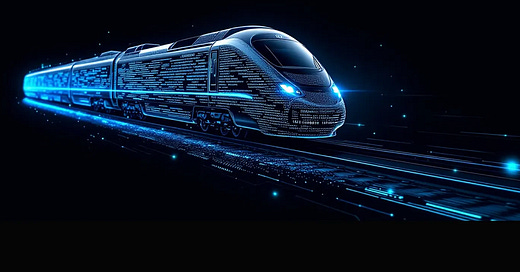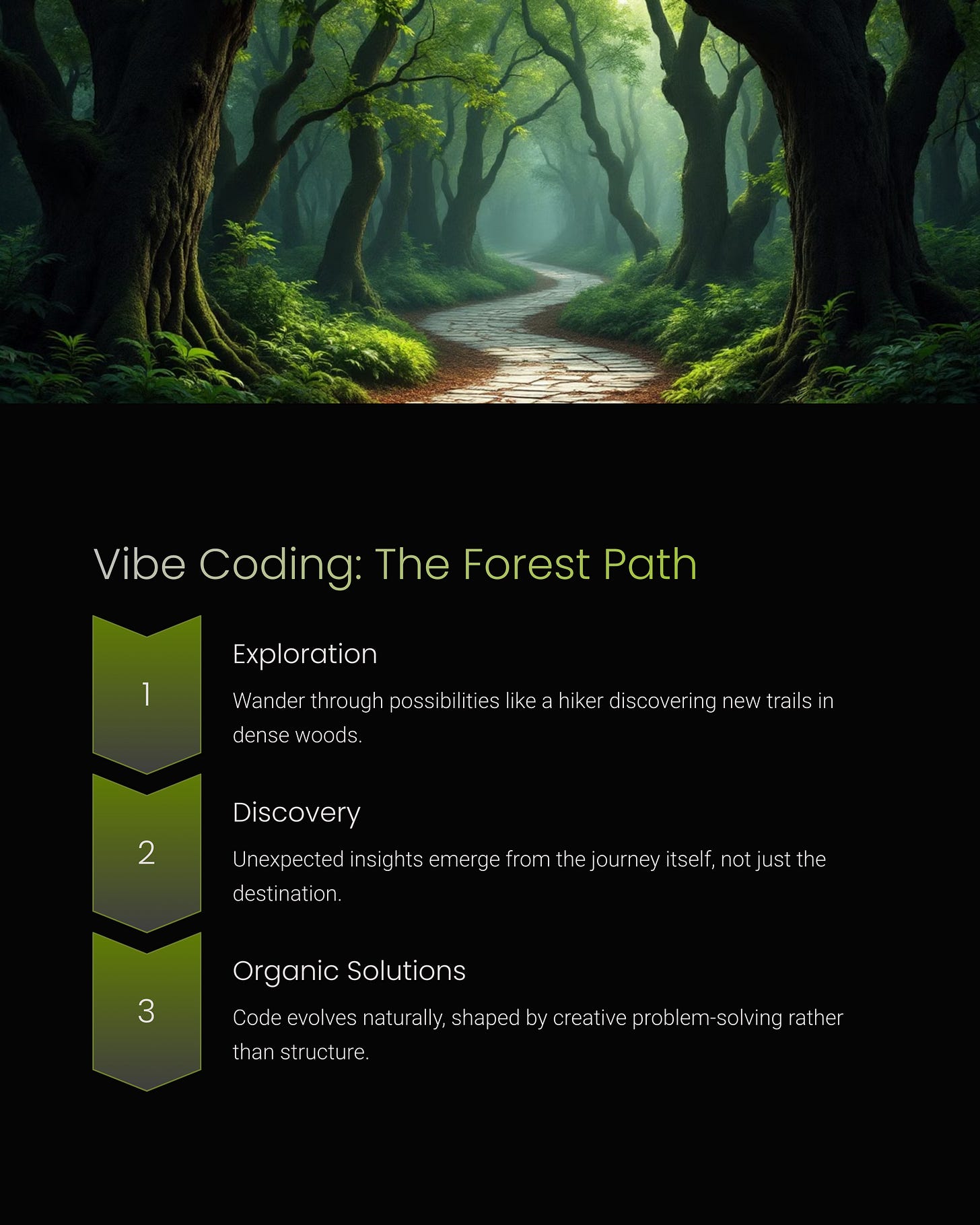From Vibes to Velocity: The Mental Models That Separate 10x from 100x Developers
How toggling between exploratory and deterministic modes is reshaping what's possible in the age of AI pair programming
The Silent Revolution in How We Build
After nearly two decades in software development and recently hundreds of hours developing with AI, I’ve observed a fascinating pattern among teams thriving with AI tools. While everyone's racing to integrate GitHub Copilot, Claude, or GPT into their workflow, the real differentiator isn't which AI they've adopted, but how they're using it.
Specifically, the highest-performing developers have developed "context-switching intelligence": the ability to deliberately shift between fundamentally different mental models based on the challenge at hand.
This isn't just an incremental improvement to how we write code, it's a complete reimagining of what it means to be a developer:
Yesterday: Writing code faster = 10x developer
Today: Orchestrating AI + human creativity = 100x developer
Two Mental Models: Different Paths to Creation
Vibe Coding: The Explorer's Path
Vibe coding embraces an exploratory, non-linear approach—like wandering through uncharted territory with a compass rather than a map. This mode thrives when:
The problem space feels fuzzy or poorly defined
Conventional solutions aren't cutting it—something novel is needed
Learning and discovery are as valuable as shipping code
Vibe coding is about to be a much bigger part of the interview process—regardless of role type. In the near-term, it's going to be used as a validation technique for creativity/expression as well as problem solving/critical thinking (in the same way Conway's Game of Life is sometimes used for gameplay engineers). No shirt, no shoes, no vibe code, no job.
—Jordan Carver, Talent Partner at a16z quoted here
When implemented thoughtfully, vibe coding creates space for those breakthrough moments that never emerge from linear, requirements-driven development.
Velocity Coding: The Builder's Highway
In contrast, velocity coding represents a deterministic, implementation-focused approach like driving on a well-mapped highway or a high-speed train with clear directions to your destination. This mode excels when:
You can see the finish line and know the path to get there
Speed of delivery matters most
Implementation rather than exploration is your primary goal
Y Combinator President Garry Tan recently highlighted the power of this approach here:
"Every software co in the world is going to switch to AI copilot assist and they’re going to be looking for the best people able to use it Engineers have a few moves: get to the edge of what is possible with AI (becoming great with AI copilot) or start their own startups using it"
The productivity gains here are undeniable: AI assistants can implement standard patterns, generate boilerplate, and automate repetitive tasks with unprecedented speed.
The Key Insight: It's About Switching Modes
Most teams fall into either “always exploring” or “always executing” mode, missing the power of deliberate switching. To master software development in this new world, we need a fundamentally different approach: "contextual mode-switching."
Consciously switch modes based on where you are in the development process
Use vibe coding for discovery phases when defining problems and exploring solution spaces
Shift to velocity coding for execution when implementing well-defined features
Maintain tight feedback loops between both approaches
Knowing When to Switch: Beyond Gut Feel
What makes mode selection particularly challenging is that it's not always obvious which approach will be most effective. Through many many pairing sessions, I've identified several signals that help make this decision:
Switch to vibe coding when:
You feel stuck in a cycle of incremental improvements
Requirements keep shifting under your feet
You catch yourself saying "there must be a better way"
The problem hasn't been solved before in your specific context
Switch to velocity coding when:
The solution pattern is clear and established
Speed of delivery has become the primary concern
You're implementing something you've built before
Resources (time, budget, team energy) are running low
The Orchestra Conductor: Multiplying Impact
The emergence of these complementary approaches has given rise to a new archetype I call the "AI Orchestrator". Developers who strategically direct multiple AI systems across different phases:
ChatGPT → rapid prototyping and exploration
GitHub Copilot → implementation acceleration
Vercel AI SDK → production deployment
System integration → 5x output with the same team size
This orchestration approach transcends individual tools to create integrated workflows that transform entire development processes. The best orchestrators achieve results that once required much larger teams, fundamentally changing what's possible for lean engineering organizations.
Beyond Traditional Metrics: Measuring True Impact
Standard productivity metrics like LOC or story points completed will fail to capture what's happening through this dual-mode approach. Instead, forward-thinking teams track:
Time-to-value: How quickly does code deliver actual business impact?
Solution elegance: How maintainable and adaptable is what you've built?
Team capacity: How many parallel initiatives can you successfully juggle?
Learning velocity: How quickly does your team adapt to new challenges?
Teams that master both modes will consistently outperform their peers on these dimensions, often by multiples rather than percentages.
Reflect on these before implementation
For teams looking to implement this dual-mode approach, I recommend starting with these concrete steps:
Identify your team's default mode: Does your team unconsciously favor exploration or execution? Most have a strong bias toward one.
Create explicit space for both modes: Schedule dedicated "exploration sessions" separate from execution-focused implementation sprints.
Develop clear switching signals: Establish team-wide indicators for when to transition from exploration to implementation.
Practice mode-switching deliberately: Help team members recognize which mode will be most effective for different challenges.
Focus on outcomes, not activities: Measure the value delivered rather than how it was created.
The Path Forward
The complementary modes of vibe coding and velocity coding represent more than new workflows. They fundamentally reimagine the creative process in the age of AI-augmented development.
By consciously choosing the right mode for each development challenge and thoughtfully orchestrating AI systems across the development lifecycle, today's teams can achieve what once seemed impossible: building better software, faster, with more sustainable processes.
The question isn't whether to use AI in your development process, it's whether you're intentionally switching between these mental models to maximize their complementary strengths.
I'm curious: Have you noticed yourself naturally shifting between these modes? Which do you default to, and how do you decide when to switch? Share your experiences in the comments.
Sources:
a16z speedrun
"8 Hot Takes on Vibe Coding Games,":
- (@garrytan) on Twitter/X: https://x.com/garrytan/status/1901636857638899720
More Reading:
- , "Is Vibe Coding the Future of Software Engineering?", The Pragmatic Engineer
- , "12 Rules To Vibe Code Without Frustration," Creator Economy:












